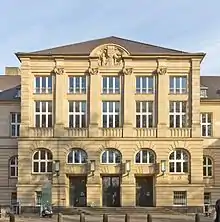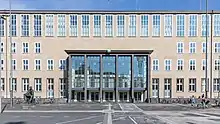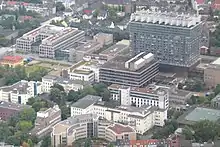University of Cologne
The University of Cologne (German: Universität zu Köln) is a university in Cologne, Germany. It was established in the year 1388, the sixth university to be established in Central Europe.[2] It closed in 1798 before being re-established in 1919. It is now one of the largest universities in Germany with more than 50,000 students.[1] The University of Cologne is a member of the German U15 association of major research-intensive universities and was a university of excellence as part of the German Universities Excellence Initiative from 2012 to 2019. It is constantly ranked among top 20 German universities in the world rankings.
Universität zu Köln | |
.svg.png.webp) University seal of 1392 | |
| Latin: Universitas Coloniensis | |
| Type | Public |
|---|---|
| Established | 1388 |
Academic affiliation | U15 |
| Budget | €897.9 million[1] |
| Rector | Joybrato Mukherjee |
Academic staff | 7,393[1] |
| Students | 50,792[1] |
| Location | , , Germany 50°55′41″N 6°55′43″E |
| Campus | Urban |
| Website | university.cologne |
University of Cologne has 4 Clusters of Excellence; CECAD Cluster of Excellence for Aging Research, Cluster of Excellence ECONtribute: Markets & Public Policy, CEPLAS Cluster of Excellence for Plant Sciences and Cluster of Excellence Matter and Light for Quantum Information (ML4Q). As of 2022, among its notable alumni, faculty and researchers are 4 Nobel Laureates, 11 Gottfried Wilhelm Leibniz Prize winners, 7 Humboldt Professorship winners, 2 Humboldt Research Awards winners and 1 Rhodes Scholar.
History

1388–1798
The university of Cologne was established in 1388 as the fourth university in the Holy Roman Empire, after the Charles University of Prague (1348), the University of Vienna (1365) and the Ruprecht Karl University of Heidelberg (1386). The charter was signed by Pope Urban VI. The university began teaching on 6 January 1389, and operated for several hundred years.
In 1798, the university was abolished by the French First Republic, who had invaded Cologne in 1794, because under the new French constitution, many universities were abolished all over France. The last rector Ferdinand Franz Wallraf was able to preserve the university's Great Seal, now once more in use.
1919–today

In 1919, the Prussian government endorsed a decision by the Cologne City Council to re-establish the university. This was considered to be a replacement for the loss of the University of Strasbourg on the west bank of the Rhine, which contemporaneously reverted to France with the rest of Alsace. On 29 May 1919, the Cologne Mayor Konrad Adenauer signed the charter of the modern university.
At that point, the new university was located in Neustadt-Süd, but relocated to its current campus in Lindenthal on 2 November 1934. The old premises are now being used for the Cologne University of Applied Sciences.
Initially, the university was composed of the Faculty of Business, Economics and Social Sciences (successor to the Institutes of Commerce and of Communal and Social Administration) and the Faculty of Medicine (successor to the Academy of Medicine). In 1920, the Faculty of Law and the Faculty of Arts were added, from which latter the School of Mathematics and Natural Sciences was split off in 1955 to form a separate Faculty. In 1980, the two Cologne departments of the Rhineland School of Education were attached to the university as the Faculties of Education and of Special Education. In 1988, the university became a founding member of the Community of European Management Schools and International Companies (CEMS), today's Global Alliance in Management Education.
The university is a leader in the area of economics and is regularly placed in top positions for law and business, both for national and international rankings.
Organization

The University of Cologne is a statutory corporation (Körperschaft des öffentlichen Rechts), operated by the Federal State of North Rhine-Westphalia.
Faculties
The university is divided into six faculties, which together offer 200 fields of study. The faculties are those of Management, Economics and Social Sciences, Law, Medicine (with the affiliated University clinic), Arts, Mathematics and Natural Sciences and Human Sciences.
| Faculty | Students |
|---|---|
| c. 10,000 | |
| c. 5,000 | |
| c. 3,200 | |
| c. 16,500 | |
| c. 7,500 | |
| Faculty of Human Sciences | c. 2,800 |
Rectors

On 24 November 2004, the physicist Axel Freimuth was elected as Rector of the University. His (initially four-year) term began on 1 April 2005. He succeeded Tassilo Küpper and was the 49th Rector since 1919. He was previously Dean of Mathematics and Natural Sciences.
Academic profile
The University of Cologne is member of the association German U15 e.V. which is a coalition of fifteen major research-intensive and leading medical universities in Germany with a full disciplinary spectrum.
Especially the faculties of law and economics are renowned and leading in Germany. Leading researchers are affiliated to Cologne: e.g., Angelika Nußberger, Thomas von Danwitz, Claus Kreß, Martin Henssler, Ulrich Preis, Heinz-Peter Mansel.
Apart from these, affiliated persons with the university have won various awards including Max Planck Research Award, Cologne Innovation Prize (City of Cologne), Postbank Finance Award (Deutsche Postbank), Ernst Jung Prize in Medicine (Jung Foundation), SASTRA Ramanujan Prize, Wilhelm Vaillant Prize (Wilhlem Vaillant Foundation), Heinz Maier Leibnitz Prize (DFG), Alfried Krupp Prize for the Advancement of Young Professors, Innovation Prize of the State of NRW, Karl Arnold Prize (North Rhine-Westphalia Academy of Sciences and Arts).
Rankings
| University rankings | ||||||||||
|---|---|---|---|---|---|---|---|---|---|---|
| Overall – Global & National | ||||||||||
| ||||||||||
According to the QS World University Rankings, the university held the 268th position globally and the 17th position nationally in 2024.[3] The Times Higher Education World University Rankings for 2023 saw the university at the 160th place globally and 15th place at the national level.[4] In the Academic Ranking of World Universities, more commonly known as the ARWU rankings, for the year 2022, the university was ranked within the 151-200 range globally and between 6th and 9th in the national ranking.[5]
By subject
|
| ||||||||||||||||||||||||||||||||||||||||||||||||||||||||||||||||||||||||||||||||||||||||||||||||||||||||||||||||||||||||||||||||||||||||||||||||||||||||||||||||||||||||||||||||||||||||||||||||
Museums and collections
- GeoMuseum: The only natural history museum in Cologne
- Theatre Collection in Schloss Wahn: images and text from European theater from the 16th century
- Max Bruch Archive of the Institute of Musicology: autographs and writings from and about Max Bruch
- The Kathy Acker Reading Room, the personal library of author Kathy Acker.
- Musical Instrument Collection of the Musicology Institute
- Egyptian collection: Papyri and parchments, ceramics and small sculptures
- Prehistoric collection artefacts from all periods of prehistoric and early history also from foreign sites, from the Neanderthal fist to the bronze sword and iron weapons of the early Middle Ages
- Papyrus collection of the Institute of Antiquity
- Barbarastollen: Under the main building, a mining gallery was built as part of a museum for trade and industry in 1932
 Main building (east view)
Main building (east view) Building of the WiSo Faculty
Building of the WiSo Faculty Building of the Faculty of Philosophy
Building of the Faculty of Philosophy The building of the university and City Library of Cologne
The building of the university and City Library of Cologne The seminar building (built in 2009 by Paul Böhm )
The seminar building (built in 2009 by Paul Böhm ) Building of the Center for Organic Electronics (COPT)
Building of the Center for Organic Electronics (COPT)
Students and faculty

In 2005, the university enrolled 47,203 students, including 3,718 graduate students. In 2003, the number of post-doctoral researchers was 670.
There were 6,157 international students in the 2005 Summer Semester (approximately 13% of all students). Those from developing countries made up about 60%, representing a total of 123 nations. The largest contingents came from Bulgaria (10.5%), Russia (8.8%), Poland (7.4%), China (6.2%) and Ukraine (5.7%).
There are 508 professors at the university, including 70 women. In addition, the university employs 1,549 research assistants, with an additional 765 at the clinic, and 1,462 other assistants (3,736 at the clinic).
Partner universities
The University of Cologne maintains twenty official partnerships[9] with universities from ten countries. Of these, the partnerships with Clermont-Ferrand I and Pennsylvania State are the oldest partnerships. In addition, Cologne has further cooperations[10] with more than 260 other universities.
- Federal University of Ceará, Fortaleza, Brazil (since 1990)
- Sofia University St. Kliment Ohridski, Sofia, Bulgaria (since 1985)
- Sun Yat-sen University, Guangzhou, Guangdong, China (since 2005)
- Fudan University, Shanghai, China (since 2010)
- Université d'Auvergne, Clermont-Ferrand I, France (since 1962)
- Université Blaise Pascal, Clermont-Ferrand II, France (since 1980)
- Aristotle University of Thessaloniki, Thessaloniki, Greece (since 1992)
- National Law School of India University, Bangalore, India
- Hitotsubashi University, Tokyo, Japan (since 1987)
- Keio University, Tokyo, Japan (since 1981)
- University of Wrocław, Wrocław, Poland (since 2003)
- University of Rajshahi, Rajshahi, Bangladesh
- Jagiellonian University, Kraków, Poland (since 1990)
- Maxim Gorky Literature Institute, Moscow, Russia
- Volgograd State University, Russia (since 1993)
- University of Seville, Spain
- Charles University, Prague, Czech Republic (since 1999)
- Istanbul University, Istanbul, Turkey (since 2003)
- University of California at Berkeley, School of Law, Berkeley, CA, U.S.
- Duquesne University, Pittsburgh, PA, U.S. (since 2001)
- Pennsylvania State University, State College, PA, U.S. (since 1961)
Notable alumni and professors

- Albertus Magnus
- Thomas Aquinas
- Kurt Alder (Nobel Prize in Chemistry 1950)
- Benjamin List (Nobel Prize in Chemistry 2021)
- Peter Grünberg (Nobel Prize in Physics 2007)
- Heinrich Böll (Nobel Prize for Literature)
- Karl Carstens (president of the Federal Republic of Germany 1979–1984)
- Gustav Heinemann (president of the Federal Republic of Germany 1969 to 1974)
- Karolos Papoulias (former president of the Hellenic Republic)
- Martin Broszat (1926–1989), historian
- Ute Deichmann, historian
- Erich Gutenberg (founder of modern German business studies)
- Amos Grunebaum, obstetrician and gynecologist
- Jenny Gusyk, a Jewish woman of Turkish citizenship, was the first female and foreign student to be enrolled in 1919.[11]
- Sasa Hanten-Schmidt, lawyer and publicist
- Leonhard Harding, (born 1936), historian and scholar in African studies
- Hans Mayer (1907–2001), literary scholar
- Stephan Noller (born 1970), internet-entrepreneur, founder and former committee chairman
- Ernst Alfred Philippson (1900–1993), philologist
- Axel Ockenfels
- Katja Terlau (born 1970), art historian and provenance researcher
- Andreas Kaplan, German economist
- Eberhard Voit
In popular culture
The University of Cologne was commemorated on the Federal Republic of Germany's postage stamp in 1988, celebrating university's 600 years.[12]
See also
References
- "UoC at a Glance". University of Cologne (in German). Retrieved 17 October 2020.
- Prague (1348), Kraków (1364), Vienna (1365), Pécs (1367), Heidelberg (1386), Cologne (1388)
- "QS World University Rankings 2024". QS World University Rankings. Retrieved 16 July 2023.
- "World University Rankings 2024". Times Higher Education World University Rankings. 27 September 2023. Retrieved 27 September 2023.
- "2023 Academic Ranking of World Universities". Academic Ranking of World Universities. Retrieved 15 August 2023.
- "QS World University Rankings by Subject 2022". QS World University Rankings. 23 March 2023.
- "World University Rankings by subject". Times Higher Education World University Rankings.
- "ShanghaiRanking's Global Ranking of Academic Subjects 2022". Academic Ranking of World Universities.
- "University of Cologne, partner universities". www.portal.uni-koeln.de. Retrieved 17 October 2020.
- "Partneruniversitäten". Archived from the original on 17 February 2013. Retrieved 1 February 2013.
- "Who was Jenny Gusyk?". University of Köln. Retrieved 11 May 2020.
- "600 Jahre Universität zu Köln" (in German). Retrieved 17 October 2020.
Further reading
- Meuthen, Erich (1988). Die alte Universität (in German). Köln: Böhlau. ISBN 3-412-06287-1. OCLC 180392627.
- Heimbüchel, Bernd (1988). Kölner Universitätsgeschichte / 2. Das 19. und 20. Jahrhundert (in German). Köln: Böhlau. ISBN 3-412-01588-1. OCLC 612668352.
- Die neue Universität, Daten und Fakten (in German). Köln: Böhlau. 1988. ISBN 3-412-01688-8. OCLC 247418886.
- Stam, David H. (2001). "Universitäts- und Stadtbibliothek Köln". International dictionary of library histories. Chicago: Fitzroy Dearborn Publishers. ISBN 1-57958-244-3. OCLC 46944624.
External links
- Official website (in German and English)
- Absolventennetzwerk der Universität zu Köln (in German)